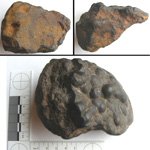Iron ore

Click ^ for larger image.
This attractive chunk of iron ore was found in a garden where the owners had lived since the 1940s. Brislington has deposits of this mineral (known as botryoidal haematite because the bumps sometimes resemble a bunch of grapes) in the Pennant sandstone rock - some grains of sand still adhere to the rust-coloured back. The exploitation of this important resource may date back to Roman times, and perhaps even further although evidence for Iron Age settlement has been difficult to find locally.
This heavy piece of ore was not found in its natural, geological context, and is part of a much larger formation; so clearly somebody carried it to its find spot. Perhaps someone was simply lucky enough to find it somewhere, felt it was too nice to leave behind, and took it home. No other similar piece was found in the garden (which was cultivated for years), so it seems this was not an industrial site involved in iron smelting - where more examples could be expected to have been scattered. However, we have classified it as metal here (rather than stone, as a geologist might expect) because it was almost certainly extracted from its native rock for its iron content.
It is noteworthy that before the road was built, this was a green field site and in 1883 the 22-acre field was auctioned. The advert boasted that it "is full of the best pennant and iron stone" (Bristol Mercury 1883). The field is identified on the 1:2,500 map of Gloucestershire in 1889, by the reference number 494.
In the absence of any way of dating this exhibit either directly or through associated finds, the idea that it was first handled in the medieval period is highly speculative, and is intended only as a rough approximation. However, a fresh fracture of this hard, brittle mineral, would leave sharp edges, but the edges of this specimen are all smooth (presumably by weathering).
Reference
Bristol Mercury 1883, Sales by Auction This Day To Capitalists Builders Market Gardeners and Others, The Bristol Mercury and Daily Post, 31 May, p 1.
Material: metal
Period: Medieval
Find spot: Jersey Avenue, Brislington, Bristol. ST 626716
Exhibit contributed by Anonymous
Text written by Ken Taylor, in 2011
Photographer: Ken Taylor
Acquisition number: 110824a1